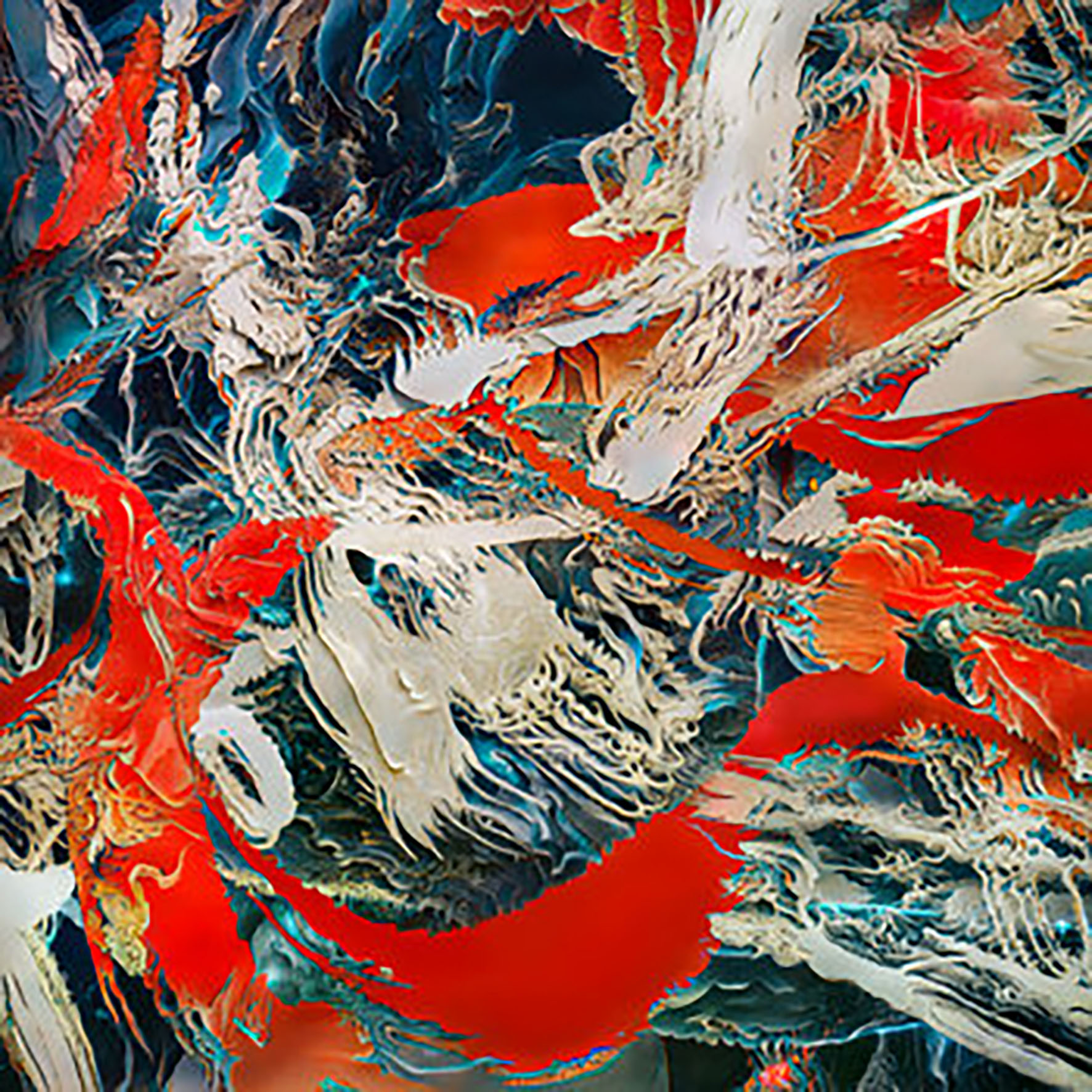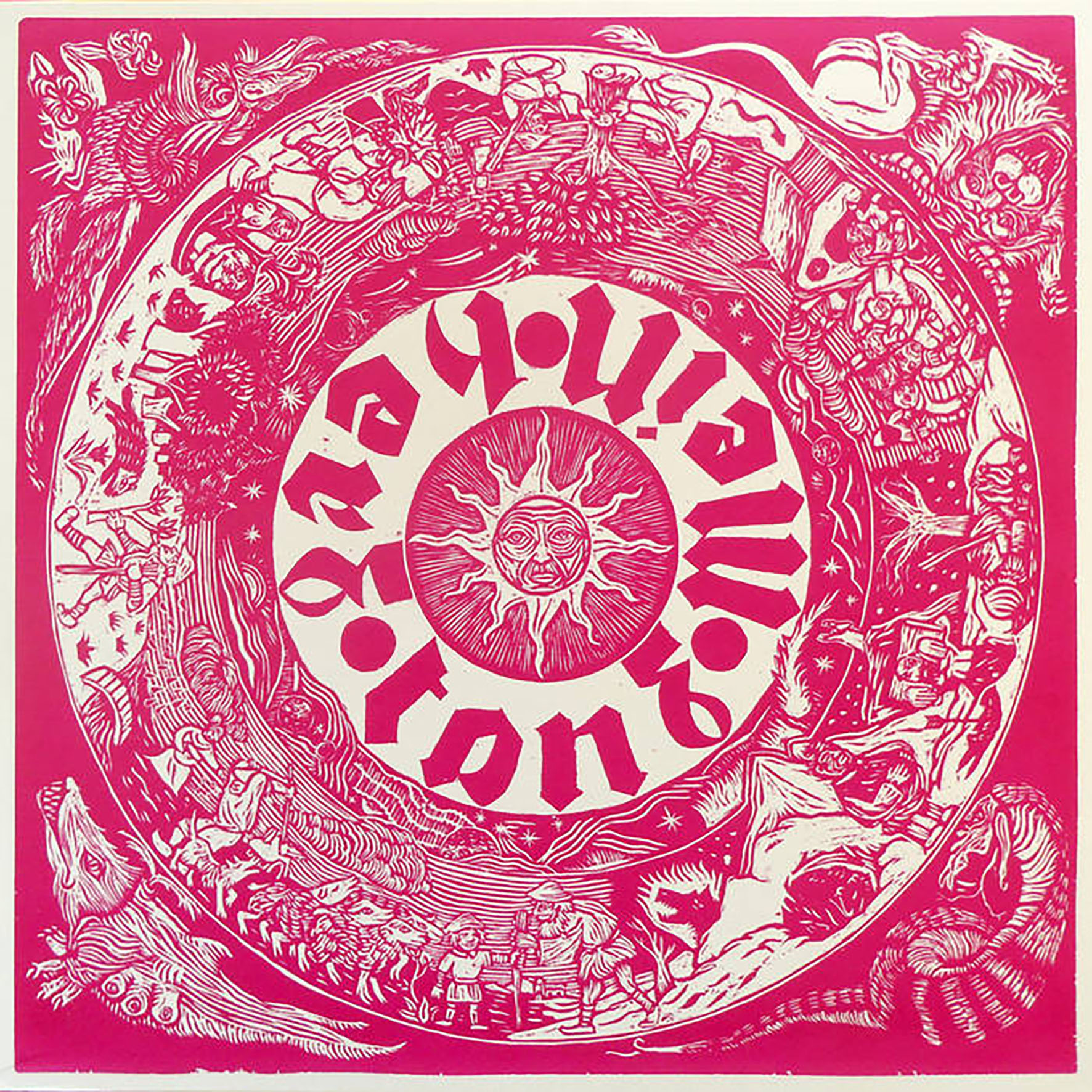 Hany Mehanna is a key figure in the development of keyboards in Asian music. As a young man he played accordion, organ, and synth in the orchestra of legendary singer Umm Kulthum and—along with Ammar Al-Sheriyi—learned to create quarter tones by using oscillators. In a later prolific period composing music for 93 films and 38 television series, Mehanna forged his own distinctive sound: a balance of traditional Arabic melody types or maqams and hypnotic experimental electronics. Remastered from his personal reel-to-reel tapes, this album showcases that balance on 19 otherworldly tracks. I like the fact I can never predict what any piece will sound like based on how it starts, even on very short tracks. Mehanna’s only other solo album, The Miracle Of The Seven Dances, was reissued in 2018 after being rediscovered in a record shop in Casablanca.
Hany Mehanna is a key figure in the development of keyboards in Asian music. As a young man he played accordion, organ, and synth in the orchestra of legendary singer Umm Kulthum and—along with Ammar Al-Sheriyi—learned to create quarter tones by using oscillators. In a later prolific period composing music for 93 films and 38 television series, Mehanna forged his own distinctive sound: a balance of traditional Arabic melody types or maqams and hypnotic experimental electronics. Remastered from his personal reel-to-reel tapes, this album showcases that balance on 19 otherworldly tracks. I like the fact I can never predict what any piece will sound like based on how it starts, even on very short tracks. Mehanna’s only other solo album, The Miracle Of The Seven Dances, was reissued in 2018 after being rediscovered in a record shop in Casablanca.
The album kicks off with “Hanady” blipping along like a wheezing, psychedelic, video game belly dance augmented by electric violin and the guitar of Omar Khorshid. On this track, and on the entire album, nothing is allowed to limp along into over-repetiive normality or to descend into an indecipherable mess. "Haya Ha’ira” is more raw, blasting into being with a razor blade guitar-like slashes and dazzling percussion and it’s over too soon. Bizarrely, the precisely chopped rhythm of "Walad Wa Bint” is virtually a compete blueprint for the verse singing on the early Stiff Records 45 “(I Don’t Want To Go To) Chelsea.”
“Rhela” has the kind of galloping rhythm and lustrous twang often associated with doomed British producer Joe Meek, as Mehanna throws hypnotic organ phrases over a frenzied beat. His breathtaking ability to layer electronics, strings, and solo instruments is evident on the library robo-funk of "Less Al Thulata” and the spaced out "Al Qina’ Al Za’ef” with (I think) twinkling synth, a lonely horn, smooth strings, and what sound like wah wah imitation vocals. There are actual vocals on "Dal Al Omr Ya Waladi,” an impressive dusky moaning which is a good counterpoint to the intriguing reedlike instrument which shares carrying the melody. Again, the mix is fabulous and the atmosphere beautifully relaxed.
On the cover Hany Mehanna almost looks like one of the heroic resistance fighters from Gillo Pontecorvo's documentary The Battle of Algiers, except—rather than a machine gun—he’s got an accordion strapped over his shoulder and stands in front of a small Farsifa organ. It is worth remembering that Farfisa organs have been used by everyone from Reich and Glass to Suicide and Cabaret Voltaire, as well as Giorgio Moroder, Pink Floyd, Sly Stone, Miles Davis, Percy Sledge, XTC, Sam The Sham, K.Frimpong, and Stereolab. Back on this album sleeve, Mehanna looks for all the world like he is sending a message on an early 1990s fax machine. In the top right a plane heads East across a circular object which might be a representation of the sun, or a piece of exotic garb I don’t recognize. The image is reminiscent of the cover from the cassette release Relaxation Tape For Solo Space Travel by The National Pool, the concept of which purports to be an actual aid for would-be cosmonauts. Music For Airports stays within the earth’s atmosphere but it definitely travels to some subtle and glamorous places. The album fell between the cracks a little with its December 2021 release date.
I haven’t had time to research the films and TV shows for each track, but the imagination may quickly run to mustachioed detectives, flared trousers, glamorous girls fallen in with a bad crowd, cool cars, cocktails, speedboats, nightclubs, ill-gotten gains, spies, shortwave radio, fistfights, heat and dust, baba ganoush, gloriously melodramatic day time soaps, switchblades, Sid James, cigarette holders, white dinner jackets, and all that jazz. The album title makes sense in the context of the modernizing of Egyptian economy in the 1970s, with a jet-set, Operation Nimbus Moon, and President Sadat standing on a destroyer when reopening the Suez Canal. Hany Mehanna's tunes fit in with any concept of freedom, and his rhythms showed up in popular songs which soundtracked the Arab Spring of 2010-12. This collection ends on a real high with the thrilling and poignant "Damat Alam" sandwiched between the Opening and End themes to “Al Dawarma.” No need to round up the usual suspects such as Basil Kirchin or eden ahbez. I think this is the beginning of a beautiful friendship.


 Meitei’s plunderphonic exploration of “lost Japanese moods” has been an intriguing and unusual project right from the start, but it started to blossom into something truly great with 2019's Komachi and only got better with the beat-driven breakthrough of 2020's Kofū. As it turns out, that creative leap forward was also quite an intensely prolific period and a lot of tough cuts needed to made to distill the resultant mountain of songs into a single album. As I loved Kofū, I have no qualms at all with Meitei's ruthless culling choices for that album, but it did leave a lot of finished and semi-finished pieces on the cutting room floor (somewhere around 50, in fact) and many definitely deserved a far better fate. Meitei's original plan was to just keep moving forward with new material in the wake of Kofū's success, yet "when it came time to begin his next album, he found that it had been sitting in front of him all along" and "realized his work wasn’t over yet." In that regard, Meitei's judgment proves to be unerring once again, as this selection of Songs That Did Not Make The Original Cut is every bit as poignant, wonderful, and deliriously fun as its predecessor.
Meitei’s plunderphonic exploration of “lost Japanese moods” has been an intriguing and unusual project right from the start, but it started to blossom into something truly great with 2019's Komachi and only got better with the beat-driven breakthrough of 2020's Kofū. As it turns out, that creative leap forward was also quite an intensely prolific period and a lot of tough cuts needed to made to distill the resultant mountain of songs into a single album. As I loved Kofū, I have no qualms at all with Meitei's ruthless culling choices for that album, but it did leave a lot of finished and semi-finished pieces on the cutting room floor (somewhere around 50, in fact) and many definitely deserved a far better fate. Meitei's original plan was to just keep moving forward with new material in the wake of Kofū's success, yet "when it came time to begin his next album, he found that it had been sitting in front of him all along" and "realized his work wasn’t over yet." In that regard, Meitei's judgment proves to be unerring once again, as this selection of Songs That Did Not Make The Original Cut is every bit as poignant, wonderful, and deliriously fun as its predecessor. With two different releases in 2021, Jim Campbell (as Rrill Bell) follows up 2020's Ballad of the External Life going in two very different thematic directions. A cassette, False Flag Rapture, is a personal, intimate work based around a recording of his grandmother, while the digital (available with printed material as well) Blade’s Return is a narrative tale about a saw (I am not sure if it is truly meant to be anthropomorphic or not). Both feel rather different from each other, but both also feature the heavy tape manipulations of Campbell, reducing instrument recordings to raw material that he shapes into entirely different and unique forms.
With two different releases in 2021, Jim Campbell (as Rrill Bell) follows up 2020's Ballad of the External Life going in two very different thematic directions. A cassette, False Flag Rapture, is a personal, intimate work based around a recording of his grandmother, while the digital (available with printed material as well) Blade’s Return is a narrative tale about a saw (I am not sure if it is truly meant to be anthropomorphic or not). Both feel rather different from each other, but both also feature the heavy tape manipulations of Campbell, reducing instrument recordings to raw material that he shapes into entirely different and unique forms. With apologies to Laurie Speigel after whose album the label takes its name (and Sylvia Tarozzi), it must be said that solo piano is at the core of Unseen Worlds. Their standards are high, as evidenced by recent releases such as James Rushford's Musicá Collada/See The Welter and "Blue" Gene Tyranny’s Detours. Human Remains is Robert Haigh’s third (and best) release for the label. His composition and playing superbly balance immediacy and detachment. This balance places a subtle disguise or mystery over these compositions. I detect a similarity with the approach of Werner Herzog in many of whose films the audience is allowed to feel and react without heavy-handed close ups.
With apologies to Laurie Speigel after whose album the label takes its name (and Sylvia Tarozzi), it must be said that solo piano is at the core of Unseen Worlds. Their standards are high, as evidenced by recent releases such as James Rushford's Musicá Collada/See The Welter and "Blue" Gene Tyranny’s Detours. Human Remains is Robert Haigh’s third (and best) release for the label. His composition and playing superbly balance immediacy and detachment. This balance places a subtle disguise or mystery over these compositions. I detect a similarity with the approach of Werner Herzog in many of whose films the audience is allowed to feel and react without heavy-handed close ups. At this point, I consider myself quite well accustomed to Markus Popp's penchant for bold stylistic reinventions, yet this latest album managed to completely blindside me nevertheless. To be fair, however, Ovidono is not quite a pure Oval album, as Popp is joined by return collaborator Eriko Toyoda and artist/actress Vlatka Alec. The latter, in fact, is responsible for the album's concept: transforming the poetry of Ovid and Ono No Komachi into sound art that evokes "the tactile, immersive quality and intimacy of ASMR." The trio definitely succeeded in that regard, as Ovidono is probably the finest ASMR-inspired album that I have yet heard, but it is also a bit more ambitious than just a hallucinatory swirl of hushed and sibilant voices. Obviously, that would have been just fine by me too, as Popp is an absolute wizard at chopping and reassembling sounds. However, Ovidono is also quite compelling compositionally, as Alec and Toyoda's voices are backed by music that lies somewhere between noirish torch song, deconstructed piano jazz, and the uneasy dissonances of Morton Feldman.
At this point, I consider myself quite well accustomed to Markus Popp's penchant for bold stylistic reinventions, yet this latest album managed to completely blindside me nevertheless. To be fair, however, Ovidono is not quite a pure Oval album, as Popp is joined by return collaborator Eriko Toyoda and artist/actress Vlatka Alec. The latter, in fact, is responsible for the album's concept: transforming the poetry of Ovid and Ono No Komachi into sound art that evokes "the tactile, immersive quality and intimacy of ASMR." The trio definitely succeeded in that regard, as Ovidono is probably the finest ASMR-inspired album that I have yet heard, but it is also a bit more ambitious than just a hallucinatory swirl of hushed and sibilant voices. Obviously, that would have been just fine by me too, as Popp is an absolute wizard at chopping and reassembling sounds. However, Ovidono is also quite compelling compositionally, as Alec and Toyoda's voices are backed by music that lies somewhere between noirish torch song, deconstructed piano jazz, and the uneasy dissonances of Morton Feldman. Discovering this London-based composer's adventurously psychedelic collages of traditional Greek music was one of 2021's great musical pleasures for me, so I was very eager to hear this ambitious double album follow up to Antiqua Graecia. As expected, it is a characteristically wonderful and unusual release, but it is also marks a detour away from Stamou's impressive run of Greek-themed albums. The theme of the aptly titled Monoliths is instead Stamou's attempt to "collide" the two sides of his working methods: live performances and studio work. By my estimation, it was a very successful collision, but it was mostly a behind-the-scenes one, as I would be hard pressed to determine where one approach starts and another begins. As a result, the more immediate and striking theme of the album for me as a listener is that each piece feels like an extended experiment in crafting an immersive, complexly layered sound world from just a single recognizable instrument. At least, that is how Monoliths unfolds for its first half, as the bottom drops out of the album's hallucinatory feast of bells, organs, and steel drums to reveal a considerably more processed, abstract, and psychotropic second hour of drone-damaged mindfuckery. That approach admittedly makes Monoliths a bit less accessible than some of Stamou’s more conventionally melodic work, but serious heads looking for a deep and sustained dive into otherworldly psych meditations will likely love this immersive tour de force.
Discovering this London-based composer's adventurously psychedelic collages of traditional Greek music was one of 2021's great musical pleasures for me, so I was very eager to hear this ambitious double album follow up to Antiqua Graecia. As expected, it is a characteristically wonderful and unusual release, but it is also marks a detour away from Stamou's impressive run of Greek-themed albums. The theme of the aptly titled Monoliths is instead Stamou's attempt to "collide" the two sides of his working methods: live performances and studio work. By my estimation, it was a very successful collision, but it was mostly a behind-the-scenes one, as I would be hard pressed to determine where one approach starts and another begins. As a result, the more immediate and striking theme of the album for me as a listener is that each piece feels like an extended experiment in crafting an immersive, complexly layered sound world from just a single recognizable instrument. At least, that is how Monoliths unfolds for its first half, as the bottom drops out of the album's hallucinatory feast of bells, organs, and steel drums to reveal a considerably more processed, abstract, and psychotropic second hour of drone-damaged mindfuckery. That approach admittedly makes Monoliths a bit less accessible than some of Stamou’s more conventionally melodic work, but serious heads looking for a deep and sustained dive into otherworldly psych meditations will likely love this immersive tour de force. This lovely and unexpected collaboration was quietly released digitally in November with no background information provided at all, but it is probably safe to say that it was recorded quite recently, as it shares a lot of common ground with the radiant drones of Growing's Diptych (2021). That, of course, also means that Gainer can sometimes feel like a welcome throwback to "classic Kranky" era drone artists like Stars of the Lid, though each piece ultimately blossoms into something more ambitious and distinctive by the end. That drone-heavy aesthetic sometimes makes figuring out where Lattimore fits in quite a challenge, as recognizable harp sounds are a bit of a rarity amidst the smoldering bass thrum and ambient shimmer. Then again, recognizable guitar and bass sounds are not exactly rampant either, so maybe all three artists opted for elegantly blurred impressionist abstraction. In any case, whatever they did worked quite well, as Lattimore and Growing's two aesthetics bleed together quite nicely and often feel like something greater than the mere sum of their parts (or at least like a very good Growing album beautifully enhanced with subtle acoustic shadings and flickers of melody).
This lovely and unexpected collaboration was quietly released digitally in November with no background information provided at all, but it is probably safe to say that it was recorded quite recently, as it shares a lot of common ground with the radiant drones of Growing's Diptych (2021). That, of course, also means that Gainer can sometimes feel like a welcome throwback to "classic Kranky" era drone artists like Stars of the Lid, though each piece ultimately blossoms into something more ambitious and distinctive by the end. That drone-heavy aesthetic sometimes makes figuring out where Lattimore fits in quite a challenge, as recognizable harp sounds are a bit of a rarity amidst the smoldering bass thrum and ambient shimmer. Then again, recognizable guitar and bass sounds are not exactly rampant either, so maybe all three artists opted for elegantly blurred impressionist abstraction. In any case, whatever they did worked quite well, as Lattimore and Growing's two aesthetics bleed together quite nicely and often feel like something greater than the mere sum of their parts (or at least like a very good Growing album beautifully enhanced with subtle acoustic shadings and flickers of melody). I began 2021 not knowing a single goddamn thing about Jeremie Sauvage, the Standard In-Fi label, or France's fascinating Auvergnat/avant-folk milieu, but I am certainly ending the year as a somewhat obsessed fan. Weirdly, this year was not an especially prolific year for the milieu, though Yann Gourdon and Sourdure had fresh releases, yet this album, the Sourdure album, and a pair of France reissues seemed to reach a lot more ears than usual and two of those ears were mine. The linguistically astute may successfully deduce that Quattro is Tanz Mein Herz's fourth album, but details beyond that are minimal and the recordings actually date from a two-day "public recording session" back in 2016 (the band's entire discography seems to have been recorded between 2014 and 2016, in fact). There is also some poetic information provided in French that makes repeated references to drones, vibrations, resonance, infinity, suspension, immensity, and a "pendulum of dreams," which I found both apt and predictably alluring. Admittedly, many of those descriptors could also apply to a host of disappointing drone albums, but I suspect the "pendulum of dreams" bit is probably the secret ingredient that makes this particular album so transcendent. That said, Quattro can also be quite challenging at times, but it unquestionably captures a very unusual acoustic drone ensemble at the very height of their eclectic and hypnotic powers, so it invariably winds up somewhere compelling no matter how prickly the voyage may become along the way.
I began 2021 not knowing a single goddamn thing about Jeremie Sauvage, the Standard In-Fi label, or France's fascinating Auvergnat/avant-folk milieu, but I am certainly ending the year as a somewhat obsessed fan. Weirdly, this year was not an especially prolific year for the milieu, though Yann Gourdon and Sourdure had fresh releases, yet this album, the Sourdure album, and a pair of France reissues seemed to reach a lot more ears than usual and two of those ears were mine. The linguistically astute may successfully deduce that Quattro is Tanz Mein Herz's fourth album, but details beyond that are minimal and the recordings actually date from a two-day "public recording session" back in 2016 (the band's entire discography seems to have been recorded between 2014 and 2016, in fact). There is also some poetic information provided in French that makes repeated references to drones, vibrations, resonance, infinity, suspension, immensity, and a "pendulum of dreams," which I found both apt and predictably alluring. Admittedly, many of those descriptors could also apply to a host of disappointing drone albums, but I suspect the "pendulum of dreams" bit is probably the secret ingredient that makes this particular album so transcendent. That said, Quattro can also be quite challenging at times, but it unquestionably captures a very unusual acoustic drone ensemble at the very height of their eclectic and hypnotic powers, so it invariably winds up somewhere compelling no matter how prickly the voyage may become along the way. Klara Lewis has been a unique and consistently interesting artist ever since she first surfaced, but 2020's Ingrid felt like a massive breakthrough and just about everything that she has released since has been stellar (live albums included). Unsurprisingly, Live in Montreal 2018 does nothing to derail that streak, but there are a couple of somewhat big surprises with it too. The first one is the date of the performance, as I had no idea that Lewis was on this plane two years before Ingrid came along. That is not to say that Live in Montreal would have necessarily eclipsed 2016's excellent Too had it been the follow up, but the Lewis of 2016 was an artist who seemed categorically disinterested in doing anything the conventional/expected way. And the comparative melodicism of 2018's fitfully great collaboration with Simon Fisher Turner (Care) felt like a one-off experiment in applying her non-musical found sounds to a more traditionally musical vision rather than a change in direction. As it turns out, however, Care was merely a tease of greater things to come and the lucky attendees of this performance got a sneak preview of those greater things long before the rest of us. The second big surprise is that this album is composed of seemingly all new material rather than variations on Lewis's existing work—it feels aesthetically akin to a proto-Ingrid, but a stage before that piece was distilled to just a single perfect motif. Obviously, that narrowing of focus yielded great results, but this more varied and shapeshifting approach yielded some legitimately great results too, elegantly blurring the lines between drone, noise, spacy synth explorations, and pop plunderphonics.
Klara Lewis has been a unique and consistently interesting artist ever since she first surfaced, but 2020's Ingrid felt like a massive breakthrough and just about everything that she has released since has been stellar (live albums included). Unsurprisingly, Live in Montreal 2018 does nothing to derail that streak, but there are a couple of somewhat big surprises with it too. The first one is the date of the performance, as I had no idea that Lewis was on this plane two years before Ingrid came along. That is not to say that Live in Montreal would have necessarily eclipsed 2016's excellent Too had it been the follow up, but the Lewis of 2016 was an artist who seemed categorically disinterested in doing anything the conventional/expected way. And the comparative melodicism of 2018's fitfully great collaboration with Simon Fisher Turner (Care) felt like a one-off experiment in applying her non-musical found sounds to a more traditionally musical vision rather than a change in direction. As it turns out, however, Care was merely a tease of greater things to come and the lucky attendees of this performance got a sneak preview of those greater things long before the rest of us. The second big surprise is that this album is composed of seemingly all new material rather than variations on Lewis's existing work—it feels aesthetically akin to a proto-Ingrid, but a stage before that piece was distilled to just a single perfect motif. Obviously, that narrowing of focus yielded great results, but this more varied and shapeshifting approach yielded some legitimately great results too, elegantly blurring the lines between drone, noise, spacy synth explorations, and pop plunderphonics. I don’t know exactly what synth-like equipment Robert Takahashi Crouch uses to generate these sounds and maneuver them into place, but these three pieces are very impressive. This is an album of abstract music and it is useful for reference to have detailed context of Crouch's personal challenges and struggle as outsider, victim, self-destructor, or whatever. I read those between my first and second listens to Jubilee and it definitely helped.
I don’t know exactly what synth-like equipment Robert Takahashi Crouch uses to generate these sounds and maneuver them into place, but these three pieces are very impressive. This is an album of abstract music and it is useful for reference to have detailed context of Crouch's personal challenges and struggle as outsider, victim, self-destructor, or whatever. I read those between my first and second listens to Jubilee and it definitely helped.
